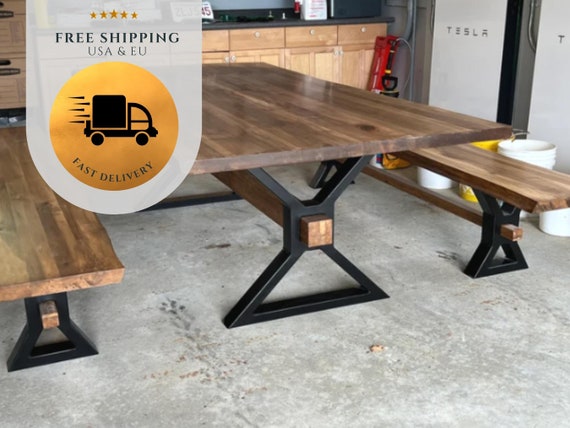The Ultimate Guide to Selecting Durable Dining Room Table Legs
The Ultimate Guide to Selecting Durable Dining Room Table Legs
Blog Article
A Detailed Look at Table Leg Styles: Locating the Perfect Match
Choosing the right table leg design is crucial for both aesthetic allure and useful capability. Traditional four legs offer classic sophistication and stability, while the pedestal base gives raised legroom and a contemporary appearance. For those with larger tables, trestle legs guarantee strong assistance, whereas hairpin legs introduce a mid-century modern vibe with their minimal style. The x-shaped legs mix contemporary style with boosted security. Each of these options brings one-of-a-kind benefits, making the selection more than just a matter of choice. Check out further to find which style completely complements your eating space and way of living.
Typical Four Legs
Amongst the different kinds of dining table leg styles, the conventional four-leg design remains an ageless choice for lots of houses. Four legs give balanced assistance, ensuring the table remains secure and qualified of birthing significant weight (dining room table legs).
From an aesthetic perspective, the standard four-leg style can be quickly adapted to various interior styles. Whether crafted from wood, metal, or a combination of products, these legs can be elaborately carved, smooth and minimalistic, or anything in between. Their flexibility allows them to enhance both rustic and contemporary settings seamlessly.
Moreover, the simple structure of the four-leg layout promotes simplicity of movement and positioning within a space. Unlike more complex bases, this design minimizes blockages, offering adequate legroom for restaurants. In summary, the conventional four-leg dining table leg style marries withstanding elegance with useful capability, making it a sharp option for those looking for both type and feature in their eating furnishings.
Pedestal Base
Frequently commemorated for its elegant and space-efficient style, the pedestal base is a notable option to the typical four-leg arrangement in eating table leg styles. This unique base normally includes a single central column supporting the table top, which can differ in type, from ornately carved timber to streamlined, contemporary steel. Among the main benefits of the pedestal base is its capacity to optimize legroom and seating versatility. Without edge legs, restaurants are paid for better liberty of movement, making it an excellent option for round and oblong tables that advertise more intimate and inclusive celebrations.
Additionally, the stand base's main support can deal with significant weight, enabling making use of larger tabletops, such as marble or thick wood. This strength coupled with its aesthetic flexibility makes the stand base a preferred option in both traditional and contemporary interior settings. It can seamlessly integrate with different design themes, from classic style to minimalist modernity. In addition, the main column itself supplies a canvas for detailed layouts and artistic expressions, including an element of visual rate of interest beneath the table. In summary, the pedestal base combines performance with design, making it a fine-tuned and sensible option for varied dining settings.
Trestle Legs
Trestle legs offer a durable and ageless structure for eating tables, characterized by their straight cross-bracing and tough support light beams. Stemming from medieval times, this style has actually progressed yet retained its crucial structure, making it a perennial favorite in both typical and modern setups. The main trestle beam of light, typically sustained by two or more vertical posts, offers extraordinary stability, enabling bigger table sizes without the need for additional legs.
A significant benefit of trestle leg tables is the adequate legroom they provide. Unlike tables with 4 corner legs, the absence of obstructions at the table's edges supplies unblocked space for chairs and restaurants, improving convenience and ease of access. This makes trestle tables excellent for suiting bigger events, whether in a dining-room or a banquet hall.
The visual adaptability of trestle legs is noteworthy. Readily available in a variety of materials such as timber, metal, and composite, they can be ended up to complement a variety of indoor Homepage designs. From rustic farmhouse to sleek contemporary designs, trestle legs can be personalized to match individual tastes. Their enduring charm and practical benefits make trestle legs an engaging option for those looking for both style and practicality in their table.
Hairpin Legs

The charm of hairpin legs hinges on their simplicity and flexibility - dining room table legs. Readily available in a series More Info of products, consisting of steel and brass, they can be completed in countless shades to complement various indoor styles. Whether coupled with a rustic wooden tabletop or a contemporary glass surface, barrette legs effortlessly mix capability with a touch of classic appeal
Sturdiness is one more noteworthy attribute of hairpin legs. Regardless of their fragile look, these legs are engineered to birth significant weight, guaranteeing the dining table continues to be secure and safe and secure. Furthermore, they are relatively very easy to mount, making them a preferred selection for do it yourself fanatics and specialist furnishings makers alike.
X-Shaped Legs

Constructed from materials such as steel, wood, or a combination of both, X-shaped legs can be tailored to match numerous design choices. Steel legs commonly lend a streamlined and industrial feel, suitable for loft-style apartment or condos and modern-day eating areas. On the other hand, wooden X-shaped legs supply a warmer, a lot more rustic charm, ideal for farmhouse or eclectic interiors. The adaptability in products permits house owners to tailor their eating tables to better fit their overall style system.
In addition, the design behind X-shaped legs makes sure also weight circulation, lessening the danger of wobbling and enhancing toughness. This makes them specifically appropriate for bigger table that call for added support. Basically, X-shaped legs blend practical engineering with modern-day aesthetic appeals, making them a timeless choice for diverse dining atmospheres.
Conclusion
A detailed understanding of dining table leg styles reveals the distinct features and advantages of each design. Trestle legs ensure robust support for bigger tables, and hairpin legs present a mid-century modern-day visual.
Report this page